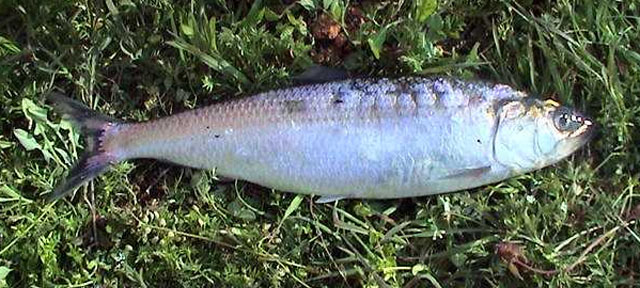| Clupeidae (Herrings, shads, sardines, menhadens), subfamily: Alosinae |
| 39 cm SL (male/unsexed); max. reported age: 7 years |
|
pelagic-neritic; depth range 3 - 90 m, anadromous |
| Eurasia: Black Sea and Sea of Azov ( in sea and in the Don, Danube and other rivers, as much as 567 km up the Don and as far as Kiev on the Dneiper before the dam was built). Recognized sub-species (Ref. 683): Alosa pontica pontica in the Black Sea and rivers feeding it; Alosa pontica kessleri and Alosa pontica volgensis in the Caspian Sea. Appendix III of the Bern Convention (protected fauna). |
|
Dorsal spines (total): 0-0; Anal spines: 0-0. Body fairly elongate, more `herring-like' than `shad-like'. Gill rakers rather thin, usually equal to or a little shorter than gill filaments. Teeth well developed in both jaws. Resembles A. caspia, which usually has more Gill rakers (50 to 180, much longer than gill filaments), poorly developed teeth and a deeper, `shad-like' body; A. maeotica has fewer Gill rakers (33 to 36). |
| Thai species is pelagic at sea, in deep water. It migrates to middle reaches of large rivers, spawning where current is strongest, close to the surface, often at 2-3 m depth in the main channel. Migrates upriver to spawn at 3 years, rarely earlier and only a few individuals spawn two seasons. It appears along the coast in March to April, enters rivers when temperatures reach about 6-9°C, between late March and late April; migration usually peaks in May. Spawning starts when temperature rises above 15°C in April to August; usually between 1 and 8 p.m. Pelagic eggs. Spent individuals return to the sea to feed. Juveniles inhabit floodplain and shallow riverine habitats, migrate to the sea or estuarine habitats during first summer; in autumn return to the sea until maturity. When at sea, it feeds on a wide variety of zooplankton (mainly crustaceans, (Crangon, Upogebia, Idothea, gammarids) and small fish (Engraulis, Clupeonella, Sprattus). Reduction of spawning sites and migration routes are caused by impoundment of main rivers. Heavy over fishing apparently reduced all populations during the first decade of the 20th century (Ref. 59043). Reaches a smaller size (30 cm SL, usually 14-18) in Don River; a smaller form reaches only 21 cm. |
|
Vulnerable (B2ab(v))
(Ref. 96402)
|
| harmless |
|
Known from the Black Sea, European Black Sea watersheds and Anatolian Black Sea watersheds (Ref. 58342). Also Ref. 106151. Found in central coast of Black Sea (Sinop and Samsun vicinity) (Ref. 88083). Threatened by commercial and bycatch fishing, habitat loss, eutrophication/pollution, construction of weirs/dams in rivers and water abstraction. Listed on Annexes II and V of the EU Habitats Directive as Alosa spp. (Ref. 58342). Also Ref. 188, 26334.
Status of threat: Endangered (Ref. 58342). EurTurk. |
Source and more info: www.fishbase.org. For personal, classroom, and other internal use only. Not for publication.
Page created by Jen, 05.08.02,
php script by kbanasihan 06/09/2010 ,
last modified by
dsantos, 20/08/10

